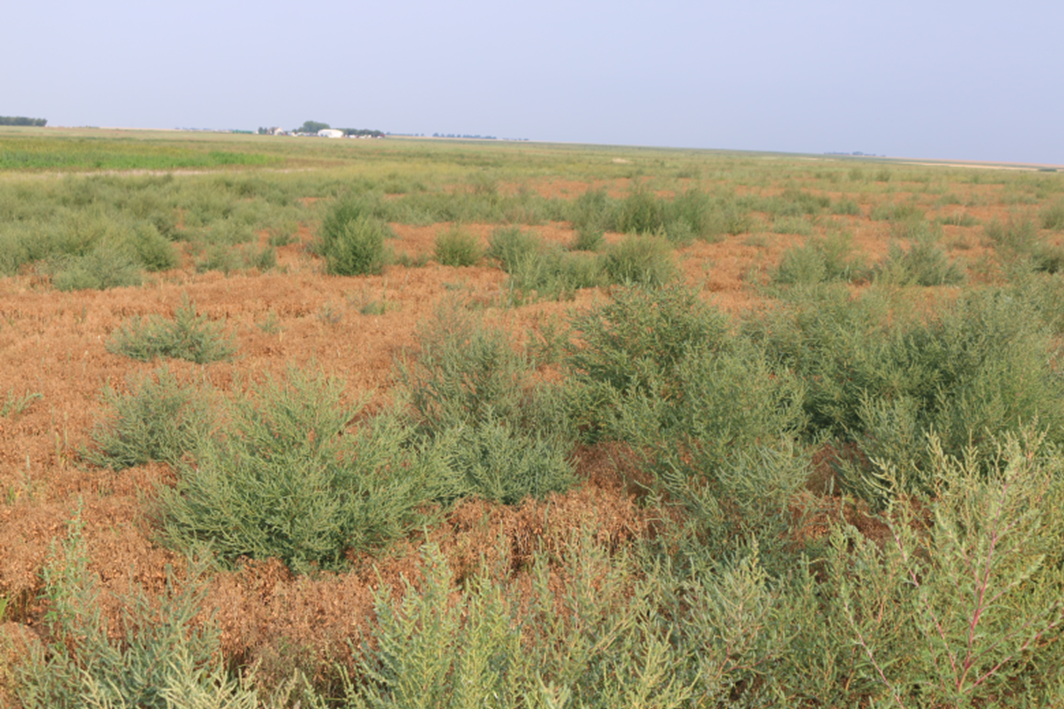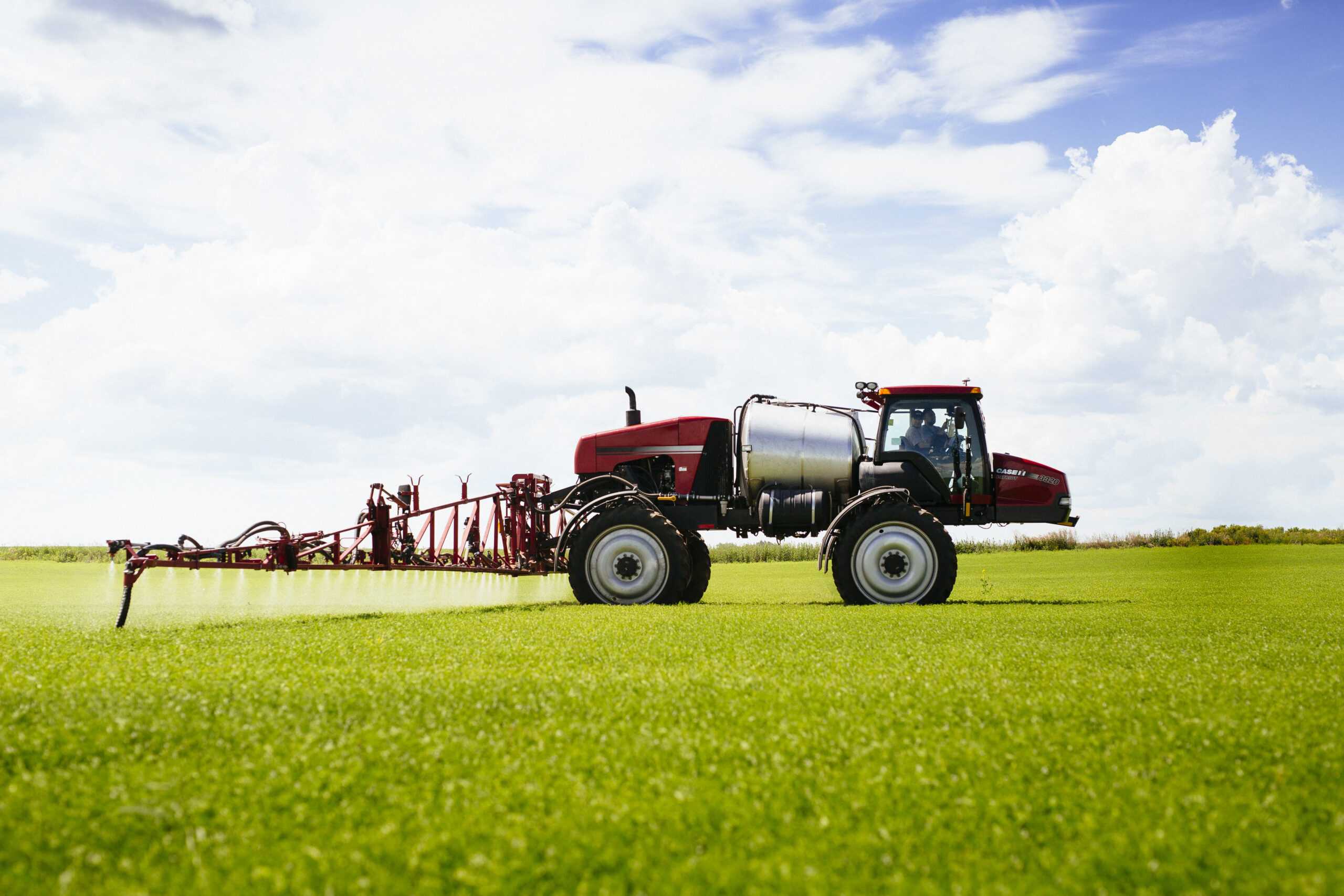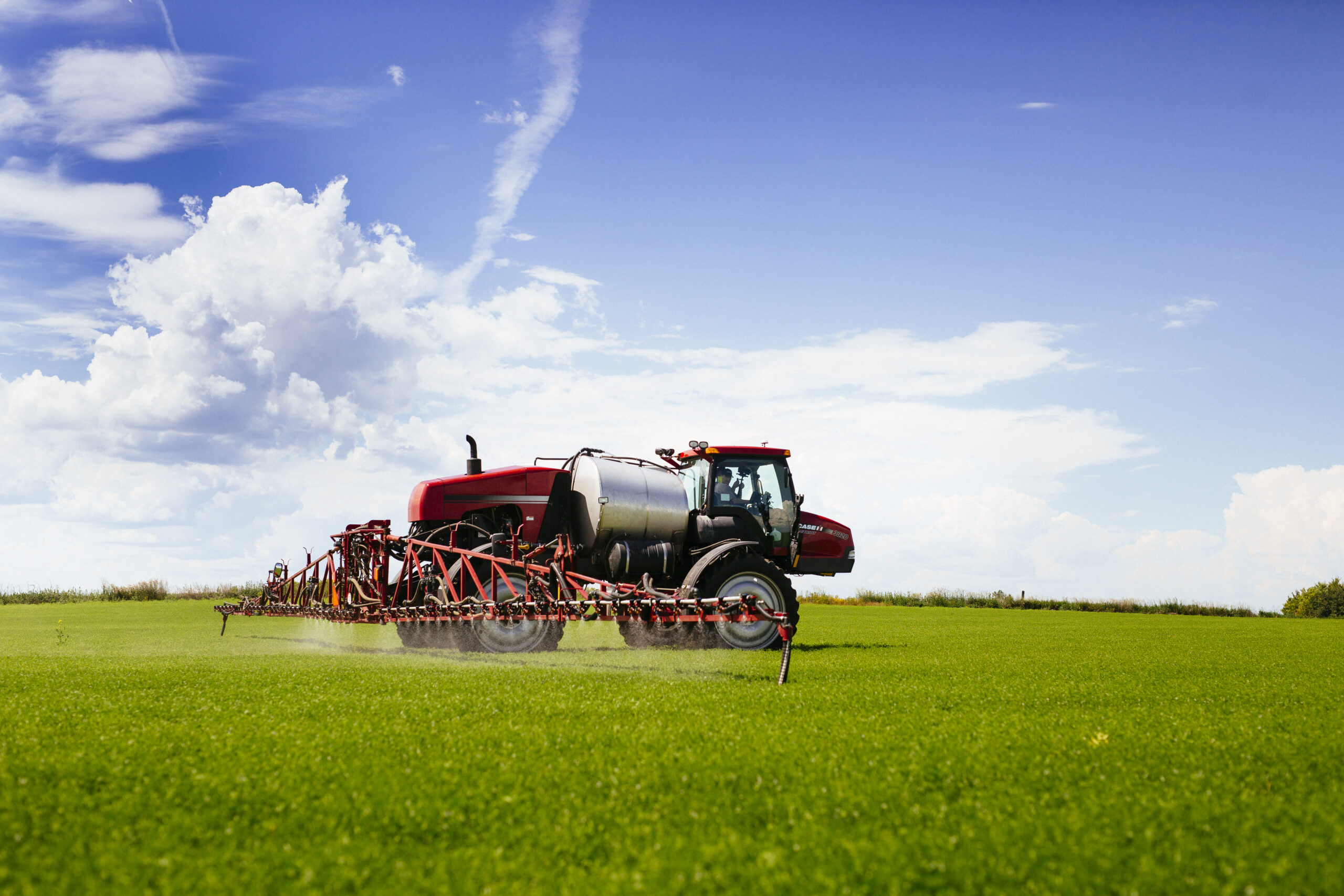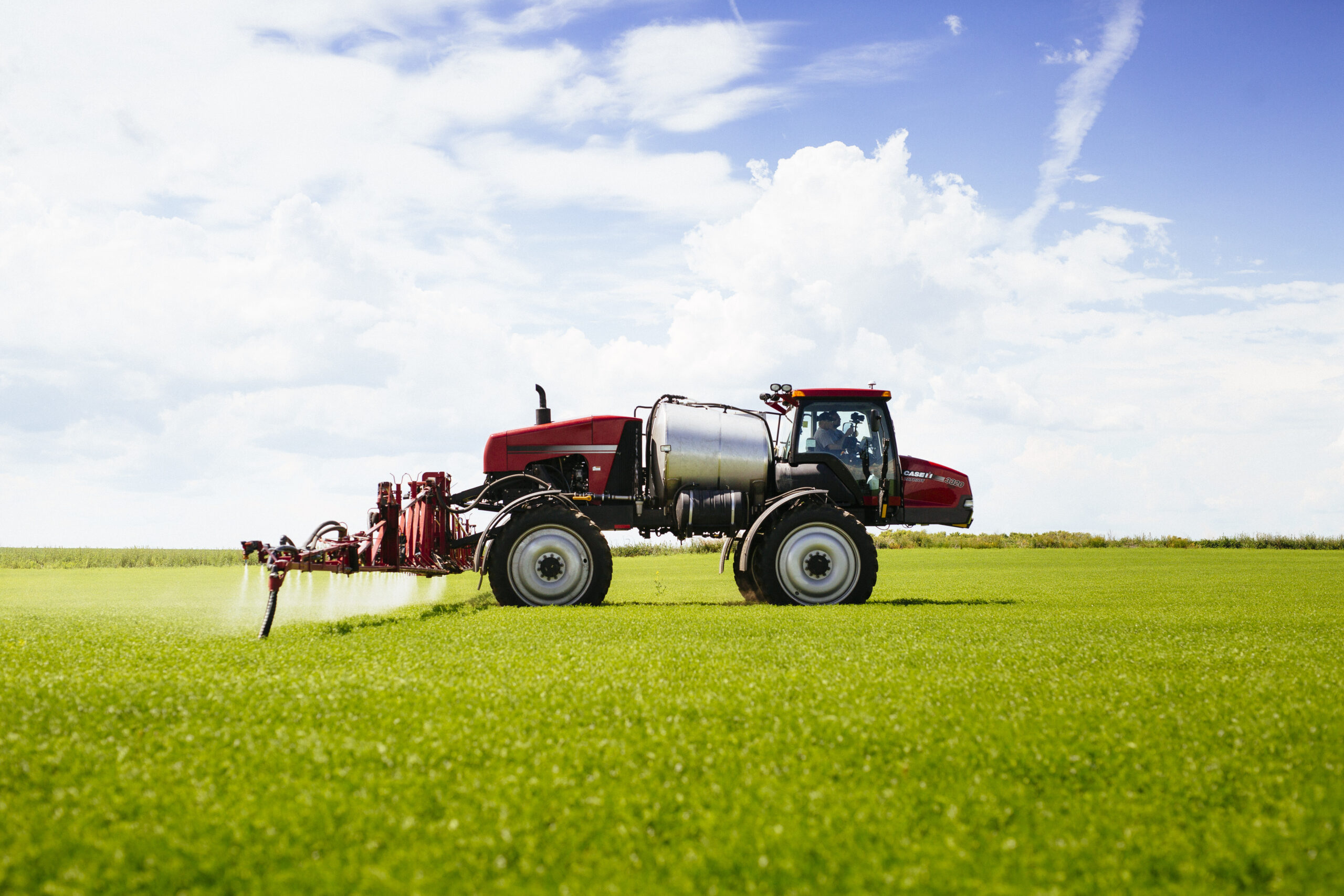Jennifer Bogdan, P.Ag., CCA
Kochia is a top weed concern for pulse growers in Saskatchewan. Well-adapted to arid and saline environments, kochia grows early in the spring, develops quickly, and is a prolific seed producer. Its tolerance to drought also adds to its competitiveness in hot, dry years. Populations resistant to herbicide Groups 2, 4, and/or 9 have been steadily increasing, making chemical control options very limited, especially in pulse crops. Harvest difficulties can arise as kochia can remain green at the same time the crop is ready to combine. Its tumbleweed nature also facilitates the dispersal of seed via wind over long distances, further increasing the spread of herbicide resistant populations and making kochia a challenge in multiple crops in Saskatchewan.
History, Distribution, and Adaptation
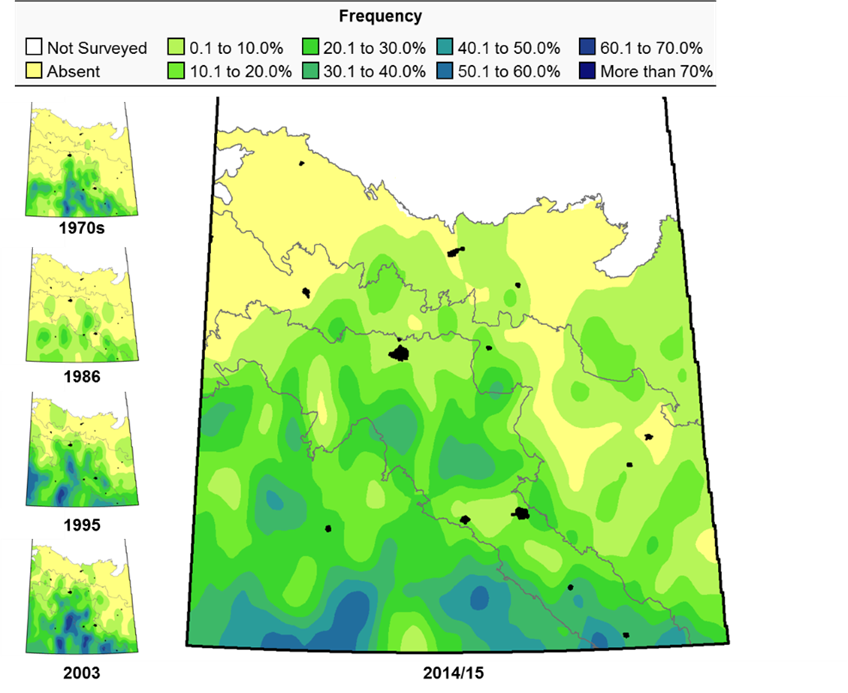
Kochia is a native plant to central and eastern Europe and western Asia, and was brought to North America by European immigrants as an ornamental in the mid-1800s. It was first documented in Canada in 1880 from a specimen collected in a vacant lot in Ottawa, ON. In Western Canada, the earliest documentation of kochia is from plants found in Altona, MB in 1901. Today, it can be found in every province in Canada, except Newfoundland and Labrador.
Weed surveys from 1948 indicated that kochia was rare in Saskatchewan and Alberta. By the late 1970s, kochia was detected in nine per cent of all fields surveyed in Saskatchewan. The kochia population peaked in the 2003 survey where it appeared in nearly 18 per cent of all fields, however it should be noted that this survey was conducted during a dry year when kochia survival is expected to be higher. In the most recent weed survey conducted in 2014/15, kochia was found in 15 per cent of all fields surveyed, and was ranked as the 15th most abundant weed in annual crops in Saskatchewan. This survey data indicates that while the kochia population is still spreading in the province, it was less abundant in 2014/15 due to less favourable (wetter) growing conditions. In pulses, kochia was present in over 25 per cent of pea fields and 23 per cent of lentil fields, and was ranked the 11th and ninth most abundant weed in peas and lentils. The next weed survey for Saskatchewan is scheduled for 2019.
Kochia is widely adaptable to a range of habitat conditions. Most notable is its high tolerance to saline soils, allowing kochia to thrive where crops cannot grow. It can also tolerate the high levels of aluminum and manganese in acidic soils that are normally toxic to plants. Kochia is an early colonizer of disturbed sites where topsoil is poor or nonexistent, such as in areas of building development, landfills, roadsides, or railroad tracks. It can also grow in abundance in nutrient-rich agricultural soils and gardens.
Frequency: The number of fields in which kochia occurred, expressed as a percentage of the total number of fields surveyed in groups such as crops or ecoregions, and in the province.
Field Density (Occurrence Fields): A measure of the number of kochia plants counted in a square metre. The density values in a single field are averaged over only the fields in which kochia occurred in groups such as crops or ecoregions, and in the province.
Source: Leeson, J.Y. 2016. Saskatchewan Weed Survey Cereal, Oilseed and Pulse Crops in 2014/15. Weed Survey Series Publication 16-1. Agriculture and Agri-Food Canada, Saskatoon Research Centre, Saskatoon, Saskatchewan
Biology
Kochia scoparia (L.) Schrad. [synonym Bassia scoparia (L.) A. J. Scott], also known as summer cypress and burning bush, is an annual herb in the Amaranthaceae family. Cotyledons are elliptical-shaped, with a green upper surface and bright pink lower surface. Leaves are linear and covered with downy hairs, mostly on the underside and margins.
Multiple branched stems form a bushy growth habit and a kochia plant can grow from 0.15 to over two metres tall, while its taproot can grow up to five metres long, and its lateral root system is also extensive.
Flowers are small, green, without petals, and grow in clusters in the axils of upper leaves. The stems eventually turn from green to red as the plant matures, and sometimes the entire plant can turn bright red or pink, making it look like a “burning bush”. When the plant dries down, the main stem breaks off at the soil surface and the plant tumbles across the land, dispersing its seeds as it rolls.

Source: Saskatchewan Ministry of Agriculture


Source: Nutrien Ag Solutions (left), Saskatchewan Pulse Growers (right)

Source: Eric Johnson, University of Saskatchewan.
Figure 6 (top right). Kochia is a tumbleweed, dispersing seeds over long distances by wind.
Source: Hugh Beckie, Agriculture and Agri-Food Canada
Figure 7 (bottom). Trails of kochia plants can be seen in chemfallow fields where the mother plant blew and scattered seeds the previous fall.
Source: Eric Johnson, University of Saskatchewan

Source: Nutrien Ag Solutions
Seeds are brown, about two millimetres long, oval-like with a groove on each side, and are often inside the star-shaped hull from the old flower parts.
Like corn, kochia is a C4 plant, meaning it has the ability to fix more carbon in its leaves so the plant can produce more energy and more sugars in hot, dry conditions than a C3 plant. C3 plants, such as peas, lentils, and soybeans, close their leaf stomata when it is hot and dry, in order to conserve water within the plant.
However, in doing so, they also prevent CO2 from entering the leaves and sugar production is shut down. The higher water-use efficiency and ability to thrive in hot, dry weather contribute to the competitiveness of C4 kochia in a C3 crop.
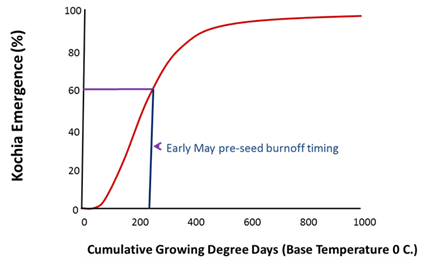
Kochia germinates early in the spring, from mid- to late April to early May, in order to take advantage of the soil moisture that may become limited in drier regions. Research from Manitoba found that kochia seedlings began emerging at 50 Growing Degree Days (GDD, base temperature 0°C) with about 60 per cent of the plants emerged within 250 GDD or early May (Figure 9). In comparison, barley emergence begins at 109 GDD (base 0°C) and canola (Brassica napus) emergence begins at 152 GDD (base 0°C).
Kochia can also emerge into June and produce additional flushes after the in-crop herbicide has been applied. Although the majority of kochia seeds only survive one to two years in the soil, mature seed does not undergo much dormancy and can easily germinate when the conditions are right. Germination can occur as soon as the upper 5-10 centimetres (cm) of soil is frost-free, in soil temperatures as low as
2-3.5°C, optimally at 25°C. Kochia seed can germinate in a wide pH range (60 to 70 per cent germination at pH 2 to 8, and 25 per cent germination at pH 10), and light exposure is not a requirement. Germination under moisture stress or salinity is reduced, but still achievable, and in the case of high salinity, germination will occur once rainfall leaches the salts away.

Source: Bethany Wyatt, BASF
Kochia is both a self-pollinating and an outcrossing species. The ability to self-pollinate allows a single plant to reproduce and colonize a new area, such as on disturbed ground. Kochia also produces protogynous flowers whereby the female flower parts (stigmas) emerge approximately one week before the male flower parts (anthers). During this time, the stigma receives pollen from outside sources and then deteriorates before pollen is released from the flower’s own anthers, thus preventing self-pollination of individual flowers. This feature makes kochia a highly outcrossing species where a high level of genetic diversity within each population can be found. Being a short day length plant, kochia begins to flower 8-10 weeks after emergence, and plants produce large amounts of pollen over an extended period of time. Pollination occurs primarily by wind and, to a lesser extent, by bees. Flowering and seed development can continue late into the season until a fall frost kills the plant. In the field, a single kochia plant can produce from 2,000-30,000 seeds, typically producing 14,000 plus seeds per plant (Figure 10).
Herbicide Resistance
Why Kochia?
The many advantageous biological features of kochia make it an ideal plant species to develop resistance to herbicides. Its low seed dormancy and low soil persistence contribute to a high germination rate and emergence of a great number of seedlings. Kochia is frost tolerant, emerges early in the spring, grows quickly in a wide range of soil conditions (high salinity, acidic to alkaline pH, disturbed areas), and is a C4 plant tolerant of heat and drought. It is self-pollinated but also highly outcrossed, allowing for high genetic diversity within populations, as well as the quick spread of single, dominant genes to other kochia plants short distances away. Kochia is a prolific seed producer and its tumbleweed nature allows for the spread of resistant seeds across long distances via the wind.
Herbicide Resistance Timeline
Herbicide-resistant kochia in Saskatchewan was first documented in 1988 with populations resistant to ALS inhibitor/Group 2 herbicides. Since 1988 resistance has continued to expand in kochia populations across Western Canada to include Group 2, 9, and 4 herbicides (Table 1). In Alberta, compared to the baseline survey in 2012, the incidence of glyphosate resistance has increased from four per cent to 50 per cent of kochia populations, and dicamba resistance has increased from undetected to 18 per cent resistant. Testing the dicamba-resistant samples for cross-resistance to fluroxypyr still needs to be completed. In Kansas, the first case of a kochia population showing resistance to four herbicide modes of action has been confirmed, with resistance to Group 2, dicamba, PSII inhibitors (Group 5, specifically metribuzin and atrazine), and glyphosate.
Mechanisms of Resistance
Resistance of kochia to the different herbicide modes of action is achieved through various mechanisms. ALS-inhibitor (Group 2) herbicide resistance is caused from a target-site mutation, meaning that the ALS enzyme in the kochia plant has been changed (mutated) so the herbicide cannot bind to the enzyme, and has no effect on the plant. Three different mutations have been identified in kochia populations in Western Canada, suggesting that Group 2 resistance can develop independently within populations, and did not originate from a single source. Glyphosate resistance in kochia is due to gene amplification, where the EPSPS enzyme (the target enzyme for the glyphosate molecule) multiplies and produces many copies of itself. The glyphosate binds to the EPSPS enzymes until it is all tied up, and the extra EPSPS copies allow the plant to keep growing. This mechanism allows the plant to tolerate high levels of glyphosate that would normally kill it. Glyphosate-resistant kochia found on the Prairies can survive glyphosate applications at rates beyond which are registered for application in Western Canada.
Dicamba resistance in kochia can be conferred by multiple mechanisms and is inherited by a single, dominant gene. Interestingly, there is a fitness penalty with this mutation and dicamba-resistant kochia populations exhibit slower growth and reduced seed production, compared to dicamba susceptible populations.
Table 1. Timeline for Confirmation of Resistance in Kochia Populations in Western Canada
| 1988 | Resistance confirmed in Saskatchewan to Group 2 herbicides |
| 2007 | 85 per cent of kochia in Western Canada resistant to Group 2 herbicides |
| 2011 | First field in Western Canada with glyphosate (Group 9) resistance confirmed in Alberta |
| 2012 | Baseline survey in Alberta found four per cent Group 2 and Group 9 and 100 per cent Group 2 resistance First field in Saskatchewan confirmed with glyphosate resistance |
| 2013 | Baseline survey in Saskatchewan found five per cent Group 2 and Group 9 resistance |
| 2015 | First field with resistance to Group 2, and 4 (dicamba and fluroxypyr) confirmed in Saskatchewan |
| 2017 | Survey in Alberta confirmed 100 per cent Group 2, 40 per cent Group 9, eight per cent dicamba, and 10 per cent three-way resistant. In total there were 50 per cent of the populations resistant to Group 9 and 18 per cent to dicamba |
Impact of Chemfallow on Resistance
The majority of fields where glyphosate-resistant kochia was first confirmed were chemfallow fields in Alberta and Saskatchewan. Chemfallow can select for glyphosate-resistant populations because multiple applications of glyphosate are made, often without a tank-mix, and there is no crop competition to help suppress the weeds. When glyphosate is used alone multiple times, it puts heavy selection pressure onto the kochia population and individuals resistant will survive. Simply adding dicamba as a tank-mix with glyphosate, once glyphosate-resistant kochia has developed, will only then select for a glyphosate-resistant and dicamba-resistant kochia population. A lack of tank-mix options, especially for multiple resistant kochia populations, increases the reliance on the few available modes of action, inevitably selecting for additional multiple resistance. The value of chemfallow should be re-examined, taking into account the presence of glyphosate-resistant kochia already in the field, or the potential of glyphosate resistance developing on the farm.

Source: Hugh Beckie, Agriculture and Agri-Food Canada
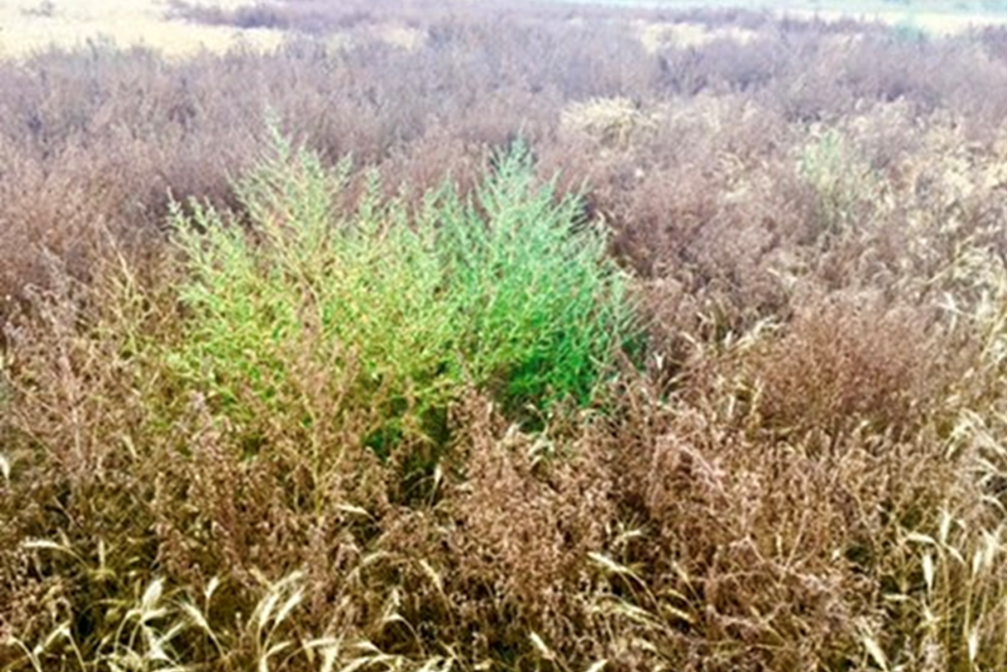
Source: Lyle Cowell, Nutrien Ag Solutions
Resistance Testing
If kochia resistance is suspected, seed samples can be sent to Agriculture and Agri-Food Canada’s (AAFC) prairie-wide herbicide resistance diagnostic testing service. This service offers free testing for Group 4 resistant kochia, all suspected glyphosate-resistant weeds, and other unique cases of herbicide resistance in Alberta, Saskatchewan, and Manitoba. This service is available to growers or or agronomists and the information is kept confidential. The goal is to help identify the problem early so growers can start managing herbicide-resistant kochia before it becomes a much bigger problem (Figure 12). The screening tests require between 1,000 to 2,000 viable seeds in total from at least 15 plants in the population. Seeds are best collected in October, put in a paper bag and shipped to AAFC Lethbridge. Testing occurs over the winter months and takes about three months to complete, assuming good seed germination. Contact Dr. Charles Geddes (charles.geddes@canada.ca) for a sample submission form or for more information.
Kochia Management in Pulses
Integrated Weed Management
Based on how quickly glyphosate-resistant and dicamba-resistant kochia populations are increasing, shifting the mindset to incorporate more cultural control methods will need to occur in order to reduce dependency on herbicides, and to save the few remaining modes of action for when they are most effective.
Herbicides are an important tool for kochia management but their longevity will only be maintained if they are used as part of an integrated weed management plan that also includes cultural, mechanical, and biological control.
As mentioned earlier, kochia has low seedbank persistence and the vast majority of the seed germinates within one to two years. These two biological features allow it to be more easily selected for herbicide resistance, but it is also these same properties that can potentially be exploited for weed control. The key component in kochia management is to not let it go to seed.
Chemical Control
Because of the amount of current and potential herbicide resistance in kochia, a multi-year herbicide plan should be considered for the crops seeded prior to, and after, the pulse crop in the rotation. Based on weed survey data, it can be assumed that kochia is Group 2 resistant, and since the majority of in-crop herbicides sprayed in pulse crops are Group 2, kochia control from these herbicides will be negligible. Pre-seed/pre-emergence herbicides are key for kochia management in pulse crops. Even with glyphosate or dicamba tolerant soybeans, using pre- herbicides are an important tool in preventing or managing glyphosate-resistant and/or dicamba-resistant kochia.
There are three modes of action available for pre- herbicides for kochia control before pulses: Group 3, Group 14, and Group 15. The only Group 3 option is ethalfluralin (Edge®) which needs to be incorporated after application, and for lentils, is only registered as a fall application. The majority of the pre- herbicide options for kochia are Group 14, and a number of active ingredients are now available including: carfentrazone, flumioxazin, pyraflufen-ethyl, saflufenacil, and sulfentrazone. Herbicides containing these actives have many different use patterns and are not registered for all pulse crops, so herbicide labels need to be consulted. The only Group 15 active ingredient is pyroxasulfone, which by itself just provides suppression of germinating kochia. To increase activity on kochia pyroxasulfone is available in combination group 14 herbicides including: carfentrazone (Focus®), flumioxazin (Fierce®), saflufenacil (Heat® Complete), and sulfentrazone (Authority® with Supreme). Effectiveness of the pre- herbicides that have soil residual activity is dependent on moisture to move the products into the soil where activation can occur. Many of the products are registered for fall applications prior to pulses, which ensures activation from winter snowfall. Fall applications are a great option but also one of the reasons why herbicide planning needs to be done well ahead of the pulse crop year.
While using a pre- and post-emergence (herbicide layering) strategy is a recommended practice, pulse growers in particular need to be especially careful to not overuse the Group 14 pre- herbicides, as kochia resistance to this mode of action would severely limit chemical control options for pulse crops. Group 14 (PPO Inhibitor) resistance has already been documented in multiple weed species in the same family as kochia, including palmar amaranth (United States) and redroot pigweed (Brazil).
Kochia leaves are hard to wet by herbicides, due to the presence of hairs and a crystalline wax on their surfaces. Proper herbicide rates, adjuvants, water volume, and droplet size are recommended for best control.
Cultural Control
Choose competitive crops. A well thought-out crop plan should be in place, with kochia and other main weed challenges kept in mind. Since kochia control in pulses is already difficult due to herbicide resistance issues, choosing a competitive crop where good kochia control can be achieved in the year before the pulse crop can help reduce the kochia pressure in the pulse crop the following year. Crops differ in their competitive ability and have been ranked as follows in decreasing competitiveness: winter cereals > rye > oat > barley > wheat > canola > peas > soybeans > flax > lentils.
Diversified crop rotations that include winter cereals or annual or perennial forages can help reduce kochia seedling density. Kochia does not compete well with established plant cover and, if necessary, kochia can be cut along with a hay crop to prevent seeds from returning to the soil.
Cover cropping can be used as an alternative to fallow. One field study underseeded yellow sweetclover in the previous year, then terminated the stand in June of the fallow year. Kochia density decreased by approximately 90 per cent following the termination year, due to the dense sweetclover residue layer, as well as allelopathic effects from decomposing sweetclover. The use of a legume cover crop would also add plenty of nitrogen-rich material back to the soil, a benefit not provided by fallow.
Early seeding helps crops to be more competitive against weeds in general. In particular, glyphosate-resistant kochia on the Prairies has been found to germinate later than glyphosate susceptible kochia, so seeding early could further increase crop competition against glyphosate-resistant kochia.
Increased seeding rates can help make a poorly competitive pulse crop much more competitive. In a Saskatchewan study (from 2011 to 2013) evaluating integrated weed management strategies in lentils, seeding at two times (2X) the recommended rate decreased weed biomass by 39 per cent, compared to the one time (1X) rate. In this study, the recommended 1X seeding rate target was 130 plants per square metre (m2) or 12 plants per square foot (ft2), and the 2X target was 260 plants/m2 (24 plants/ft2).
The seeding rates achieved were based on the actual germination percentage and a mortality rate of 10 per cent. Although the weed studied was XCEED® CLEARFIELD® canola (Brassica juncea, used to simulate Group 2 resistant wild mustard), the principle of improving the competitiveness of a crop stand to increase weed control still has merit for kochia management.
Manage saline areas. Saline areas that are unsuitable for crop production are typically colonized by kochia and foxtail barley, where they become a continual source of weed seeds. If a competitive crop cannot be established in these saline areas, then seed them to perennial, salt-tolerant forages to provide competition against the weeds.
Mechanical Control
Small-seeded weeds like kochia tend to be favoured under no-till systems, because optimal conditions for germination occur at or near the surface where the seeds are. Even though kochia may be more prevalent in no-till fields, reverting back to conventional tillage comes with a high cost to soil health. Targeted tillage in the case of green kochia trails in chemfallow fields, can be used to prevent suspected resistant plants from producing seed, and would leave the majority of the field undisturbed. A greenhouse study found that kochia seed buried 1 cm significantly reduced plant emergence and no seedlings emerged when kochia was buried at 4 cm. However, to apply this in a field setting (for dense patch management, as an example) would require complete soil inversion, which may not be achievable or desirable.
Other mechanical weed control options include harrowing, rotary hoe, and inter-row tillage. Organic growers utilize these tools successfully and incorporating these practises, in combination with pre-emergence herbicides, may benefit growers who are struggling with weeds in pulses. Small seedlings are easily disrupted from the seedbed and intensity of the operations can be adjusted depending on the equipment. Research at the University of Saskatchewan has shown a 76 per cent reduction in weed biomass when a combination of rotary hoe and inter-row tillage was used. In pulse crops where there are limited herbicide options for controlling Group 2 resistant weeds, mechanical operations are something to consider.
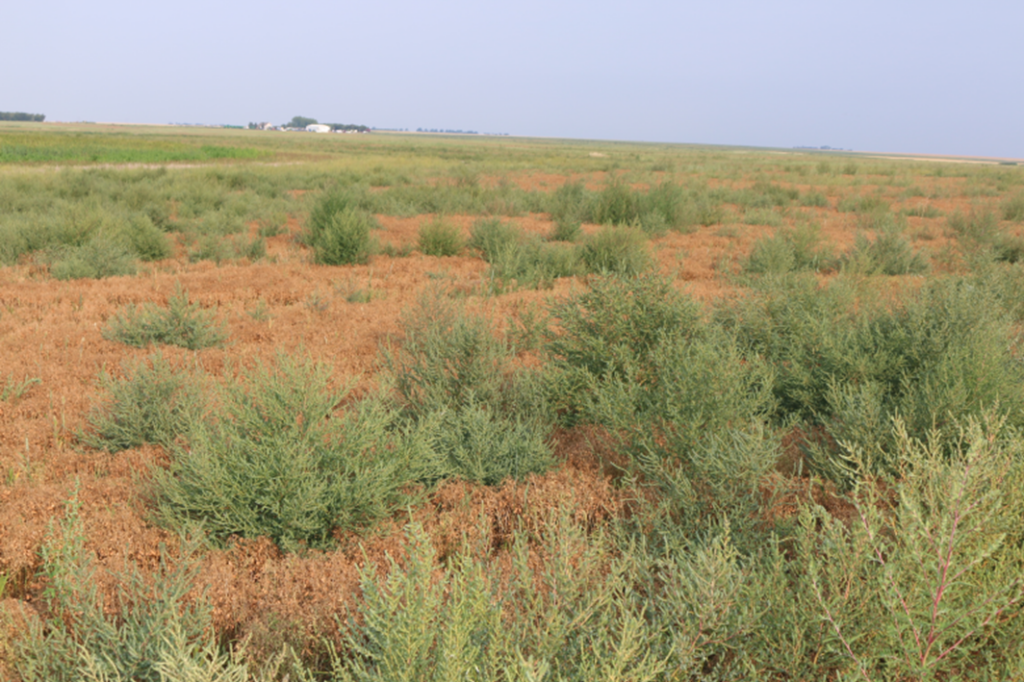
Green patches of kochia cause issues at harvest time (Figure 13). One option to manage these patches is to cut these areas for greenfeed or swath them separately before kochia produces viable seed. While research is underway, it is unclear as to exactly what stage kochia seed becomes viable, so leaving the kochia until after harvest will increase the chance of the plants having viable seed at that time. Harvest weed seed control technology shows promise for managing kochia and other problematic weed species, by reducing the number of weed seeds returned to the seedbank. Research in Alberta using a stationary tow-behind Harrington Seed Destructor resulted in the destruction of 99 per cent of kochia seeds. In the field, tumbleweeds such as kochia can be somewhat challenging if they roll off the combine header, rather than feed through it.
In non-crop areas such as ditches, mowing kochia plants before they set seed can be done, although it is possible for kochia to regrow from secondary buds underneath where the plant was cut.
Patches of kochia can be grazed, baled for hay, or silaged and fed to livestock. With a nutritional value similar to alfalfa, kochia has also been dubbed poor-man’s alfalfa. Kochia can be fed to livestock as long as it does not comprise more than 40 per cent of the diet. Immature kochia is highly palatable to grazing cattle but it is not recommended to graze pure kochia stands. Research has found that even after kochia was silaged and fed to cattle, 10 per cent of the seed still remained viable in the manure. Take caution to not bring herbicide resistant kochia seed in animal feed onto the farm.
Hand-pull isolated or suspicious plants before they set seed and tumble, if possible.
Kochia Regulation
Kochia is classified as a noxious weed under the provincial Weed Control Act, meaning that weed inspectors in RMs can authorize any kochia population to be controlled. For example, if fields showed trails of suspected resistant kochia plants, the RM could order the landowner to take necessary measures to address the issue and contain the spread, before it develops into too much of a problem for neighbouring growers.
Key Facts on Kochia Management
- Kochia produces 2,000-30,000 seeds per plant. The primary goal should be preventing kochia from setting seed, including in non-cropland areas.
- Multiple resistance to Group 2, 4, and 9 herbicides exists in kochia populations in Western Canada.
- Kochia is an annual with 60 per cent seedling emergence by early May. Pre-seed tank mixes with glyphosate and pre-emergence herbicides with soil residual activity are
important for managing germinating kochia seedlings. - Kochia will only be successfully managed when herbicides are used in conjunction with cultural and mechanical techniques.
.
